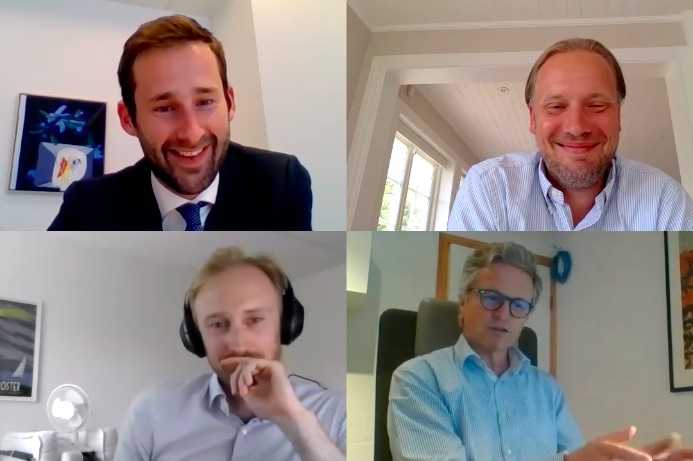In anticipation of our upcoming Annual Nordic Insurance Industry Report, we have recorded a series of roundtable discussions with CIOs of Nordic life and non-life insurers.
This series aims to discuss some of the key findings highlighted in the report and we will share these discussion leading up to the publication.
This first episode highlights the big shift from traditional, listed assets, into alternatives and private assets as investors scramble to find yield. You can read the summary in this article or watch the video below.
Panelists:
– Erik Ranberg, Chief Investment Officer of Gjensidige in Oslo, Norway
– Fredrik Ehn, Chief Investment Officer of SPP in Stockholm, Sweden
– Rens Ramaekers, Portfolio Manager, Alternative Fixed Income, Aegon Asset Management in The Hague
– Moderated by Jonas Wäingelin, Editor in Chief, NordicInvestor in Gothenburg, Sweden
In a world of lower interest rates for longer, many insurance companies need to generate some income from exposure to alternative and private credit, and have some ability to earn illiquidity and other premiums. The need for yield also needs to be carefully balanced against multiple constraints: their views on valuations and risk premiums, liquidity needs, credit ratings, Solvency II, tolerance of default risk, monetary policy outlook, view of inflation risks, operational risks and a range of other risk factors that could include real estate – as well as ESG policies.
Outlook for returns
Recent returns have been strong but they may not continue:
“It is dangerous to extrapolate from recent returns, because future returns are likely to be lower. We do not want to overweight risk assets,” says Fredrik Ehn, Chief Investment Officer, SPP.
Gjensidige CIO, Erik Ranberg, is also not aggressively adding to risk assets:
“We already had quite a bit in private and illiquid credit, so we did not change much after the Covid crisis. We are more cautious because risk premiums are depressed. Central banks have been hoarding duration and credit risk, depressing credit spreads, and forcing investors to move out on the curve. We would allocate more if risk premiums were higher”.
A wide range of risk premiums are available for different levels of risk:
“We manage internal and external money with a range of targets for yield pickup. For AAA credit ratings we aim at 50 or 100 basis points over government bonds. For AA, we aim at 150 basis points over swap. For single A such as, trade finance and insured debt , we aim for 200 bps over swap. Then for direct lending to smaller and medium sized companies we target an absolute yield of 9 to 10%,” says Rens Ramaekers, Portfolio Manager, European ABS and mortgages, at Aegon Asset Management.
Insurers are generally seeking returns at the lower end of this range, a low to mid-single digit yield pickup over government debt or possibly other benchmarks such as floating rate interest rates. This is partly a replacement for traditional investment grade debt;
“When investing in alternative fixed income assets we are primarily seeking illiquidity premiums in the range of 1-2% above the liquid alternative but sometimes it is hard to separate the illiquidity premium from additional risks premiums on asset classes such as private debt, which has other premiums such as complexity premiums,” says Ehn
Gjensidige’s targets are generally in the same ballpark:
“we are seeking a pickup of 1-4%, apart from distressed debt which has higher targets. We have tiptoed into distressed debt with a small amount to see how it works,” says Ranberg.
SPP is not in distressed debt and there is some debate over whether certain credit asset classes should be viewed as credit or equity risk:
“We are not in distressed debt partly because we would categorise it in our equity risk bucket and we do not currently have space there and partly because we do not want to have to many different small mandates,” says Ehn.
Mortgage-Backed Securities
Asset Backed Securities (ABS) is one asset class that could offer a reasonable risk premium:
“we see strong interest in ABS from clients and investors which are less (solvency) capital restricted as a replacement for traditional fixed income. For clients who are more capital restricted we see huge interest in Dutch mortgages which can offer a yield pickup of 150 basis points over EURIBOR, without the same prepayment behaviour as Danish mortgages,” says Ramaekers.
The Dutch yield pickup is to some extent an illiquidity premium, since Dutch mortgages are less liquid than Danish ones.
Denmark has the largest market in the Nordics for mortgage-backed securities, but the other countries are also of interest.
“Swedish mortgages might pay 90 basis points over STIBOR, and have very low loan to value ratios which makes it an attractive alternative to covered bonds”, says Ehn.
Default risk
House price appreciation of 25% in Sweden and Denmark over the past year reduces loan to value ratios, but mortgage securities have been perceived to have low default risk for decades or even centuries. No Danish mortgage bank has ever defaulted on a covered bond, and Dutch mortgages have also been resilient:
“even in the great financial crisis, the maximum loss on Dutch mortgages was 5 basis points in a single year. We also stress tested losses under Covid for self employed borrowers, which concluded that, in a scenario as severe as in the global financial crisis, we calculated an loss rate of 3bps.” says Ramaekers.
In corporate credit, default losses can be many times higher at the worst points of the cycle:
“there will be defaults at some point, we have to take some risk for the additional return, but still expect to beat government debt over time.Our alternative fixed income assets have a higher credit risk on average than our more traditional fixed income assets” says Ehn.
Ranberg also expects defaults at some stage:
“we get paid for default risk. We are writing put options. Defaults will often happen when you least expect them”.
Allocations
Weighing up risk and return helps insurers to determine how much they should allocate to alternative credit, which could come under a broad umbrella of alternatives, or could be grouped alongside other credit assets.
“We have 20-22% in alternatives including private equity, real estate and private debt. We are not in infrastructure as we are not sure it will survive in a climate with higher interest rates,” says Ranberg.
SPP has just started allocating to infrastructure since its parent company, Storebrand, has joined AIP along with Danish pension funds Pensam and PKA.
“The aim is to increase return, without increasing risk too much. We have an average of 35% in illiquids, which includes several buckets such as mortgages, real estate, private debt and private equity. .During the last 5-10 years we have continuously increased our exposure to alternatives and are now close to our long term strategic allocation targets. We bought a bit more liquid credit in the crisis on attractive levels, but we cannot be so opportunistic on the illiquid side, where it takes time to deploy,” says Ehn.
“We see interest in Dutch mortgages from insurers all over Europe, which allocate between 5% and 25% of their balance sheet to this strategy, which is capital efficient in terms of Solvency II,” says Ramaekers.
Monetary Policy
Fixed income assets could suffer from a normalization of interest rates though many insurers will manage interest rate risk separately through overlays and/or asset/liability management which could partly or fully hedge against rate rises. In any case, rate rises are seen as unlikely. Panellists expect interest rates to remain low:
“we agree with lower for longer and see risk premiums going down, which is the reason why investors needs to look more into alternatives.” says Ramaekers.
But there is more uncertainty about how and when central banks may reduce or cease their quantitative easing programs of asset purchases:
“we expect that central banks will keep real interest rates below zero, but we are not sure about normalization of policy. If policymakers do something at a bad moment then all hell breaks loose. We expect that they may just let paper mature, rather than offloading it,” says Ranberg.
Inflation
Inflation overshoots might force some central banks to start raising interest rates, though it may vary between countries – the US Federal Reserve might now be placing a higher priority on employment within its dual mandate.
“We do not yet know if inflation is transient. It will be interesting to see what happens to the labour market. The demand side of labour in the US is quite high but supply is not coming in yet. Norway has subdued inflation now but if commodity prices increase that triggers pay rises for certain worker groups, it will initiate dynamics for increased inflation,” says Ranberg.
Asset classes vary in how they may respond to inflation risk.
“Wage rises mean that asset backed securities should be low risk if inflation increases” says Ramaekers.
“However, default risk could increase when interest rates rise and people lose income,” points out Ranberg.
The approach to inflation protection can vary by mandates:
“our inflation protection varies by product. Products with explicit inflation guarantees are hedged with inflation linked bonds. Others with an intention to match inflation but not explicit guarantee just target a return above inflation. And other products which pay a surplus to policyholders have no inflation target at all but do have some nominal guarantee. These have a more diversified portfolio of different asset classes. Long guarantees are hedged with interest rate swap derivatives and invest in floating rate notes, benchmarked against STIBOR targets such as STIBOR flat or STIBOR plus 4,” says Ehn.
Diversification
Real estate is one obvious way to protect against inflation, but it can bring its own challenges in terms of portfolio risk and diversification.
“This contributes to a concentration risk in Swedish real estate: we own it directly and have indirect exposure from bonds backed by real estate and banks that finance real estate loans,” says Ehn. “We have the same here in Norway,” Ranberg agrees.
Real estate is only one example of possible concentrations of risks.
“We see more concentration risk as huge capital inflows run into the same themes. It is harder to diversify. And diversification also carries costs: we are operationally much more leveraged. Sometimes you wonder if you are able to split what is operational risk and illiquidity risk” says Ranberg.
Systemic risk might at least be one area that is now less of a worry than it was in 2008 or 2009:
“at least the financial system is now more diversified against shocks due to a wider and more diverse group of funders,” argues Ramaekers.
The largest risks by definition could be the most unpredictable. The late US Defence Secretary, Donald Rumsfeld, who passed away in July 2021, was famous for categorizing geopolitical risks into “unknown unknowns” and the same arguably applies to investment.
“The largest risks are the black swans that you do not know. We can explicitly hedge some risks, but anything could happen,” says Ehn.
Covid clearly came out of the blue and shocked most investors. In early July 2021 ransomware attacks, allegedly from Russia, have shut down supermarkets in Sweden. This might prove to be only a temporary and minor risk but it teaches us to expect the unexpected.
ESG
ESG criteria could reduce potential for diversification, if some asset managers do not meet the rules, especially in alternatives.
“We started many years ago with SRI, Global Compact, for the ‘S’ in ESG. Later it has evolved into ESG but we do not have proper definitions for all letters (ESG) and for all asset classes. We have developed KPIs and measurement for real estate, but private equity has a long way to go on E, S and G. For listed equity we get 93% reporting on carbon (indicator belonging to E) but only 12% for unlisted. Private credit is not easy either. The whole ESG theme is huge, but we definitely see improvements among managers and investors as regards giving the letters content in investment decisions and reporting.” says Ranberg.
When investments were made many years ago, ESG was at a much earlier stage and not all managers have kept up with the rapid evolution of ESG policies in Europe and especially the Nordics. Negotiating ESG terms with managers is now essential in many cases.
“We have minimum ESG requirements for all investments, and use side letters to ensure this commitment from asset managers. It is harder to make them commit to more detailed rules,” says Ehn.
For private investments as well as funds, negotiating the ESG details may be the way forward not only to meet minimum policies, but more ambitiously towards ESG policies that go further than regulations require:
“For a bilateral deal we can specify extra KPIs in the agreement. Some of our other conditions go beyond SFDR,” concludes Ramaekers.



